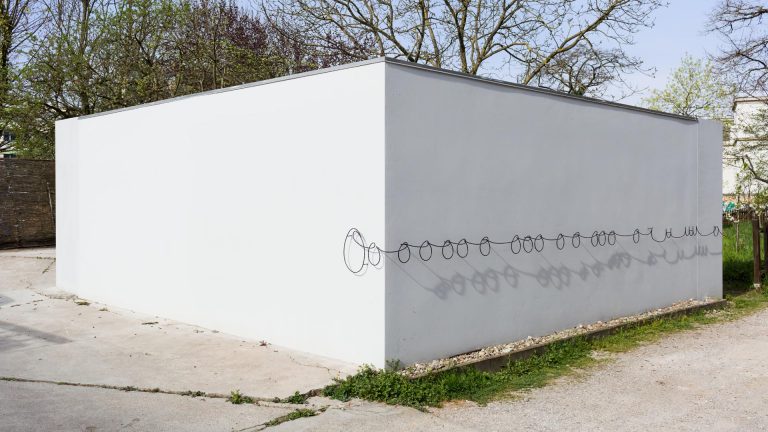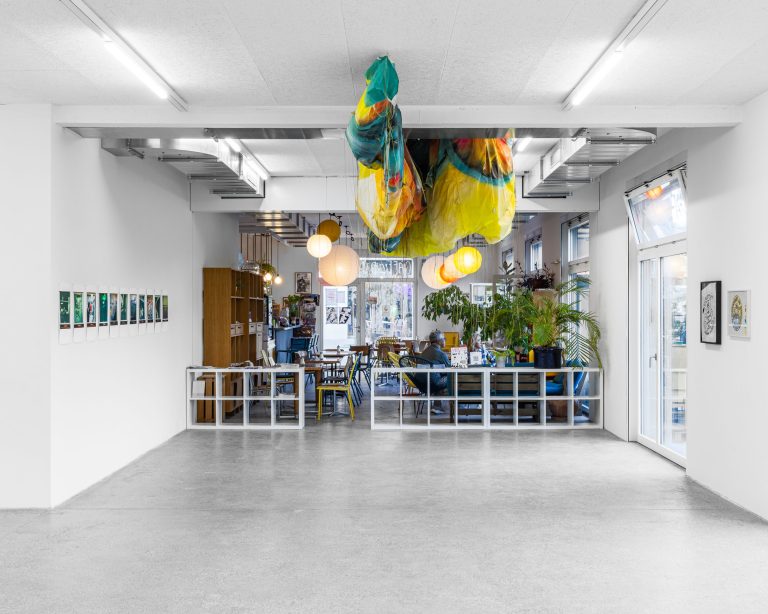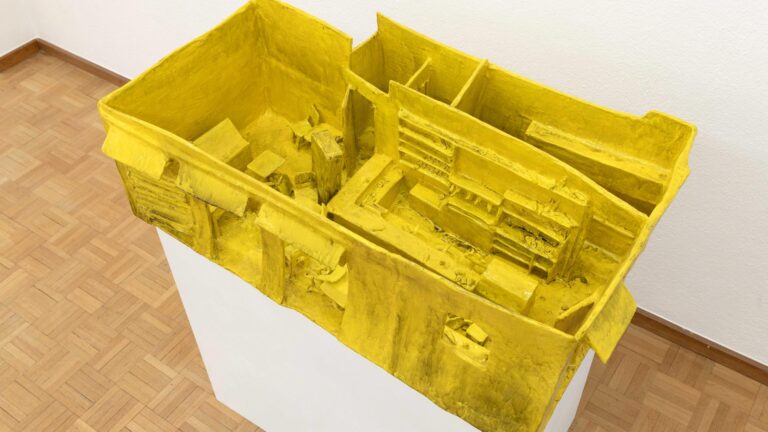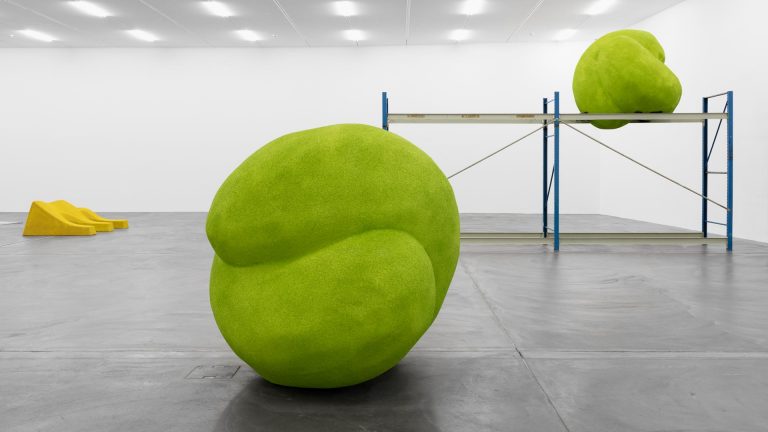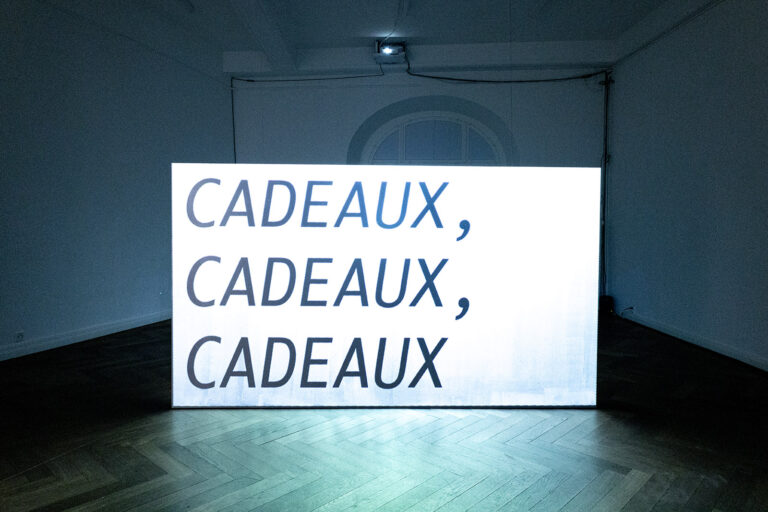Halle Nord is pleased to present the first solo exhibition by Yann Stéphane Bisso (*Sangmélima, Cameroon, lives and works in Geneva) in an institutional context, in partnership with the art space In extenso in Clermont-Ferrand (FR). This exhibition also marks the start of Elise Lammer’s artistic programming, and highlights Halle Nord’s recent efforts to disseminate the work of Geneva-based artists through targeted co-productions within an international network of allied art centres.
Featuring a new series of large-scale paintings by the artist, a sound creation by Bob1000, alias 1000 Balles, and a poetic text by Debbie Alagen, the exhibition is based on Lose Your Mother. A Journey Along The Atlantic Slave Route by Saidiya Hartman (2007), the account of a trip to Ghana during which this American historian and thinker attempted to decipher the traces of the Atlantic slave trade.
Like Hartman’s story, Pas-châssés is about understanding what makes up an archive, but also about apprehending painting as a medium for mapping—both literally and symbolically—what constitutes a diasporic “home”.
Collective memory plays a crucial role in the construction of diasporic identity, and particularly in the definition of such fragile and shifting notions as home. In Bisso’s work, the evocation of personal experiences and memories, blending fiction, legend and reality, enable him to trace the contours of a kinship and origin that are by definition hybrid.
Formally, the artist drew his inspiration from ludo, a game that is very popular in Cameroon—where the artist is originally from—and whose board is generally square, with a cross-shaped path running through its centre. The 4 paintings not only take up this spatial organisation, but also echo the rules of this game, in which each player leaves his or her home area to follow a path strewn with pitfalls in the hope of reaching the centre.
The painting Pas-châssés (2025)—which translates to “side-steps” in English—gives its title to the exhibition. In this work, Bisso portrays the everyday life of the last apartment he shared. Rendered in a monochrome palette of browns and blacks, the painting captures seemingly banal objects, revealing an intimacy whose magic lies in the details. The absence of human figures highlights the symbolic significance the artist attributes to each object, whose fixed image inevitably evokes a memory, and vice versa. Furthermore, the intrinsic question of painting itself is ever-present. This is particularly evident in the lower left-hand square, where a clumsy representation of a wooden surface questions the role of abstraction—or rather, the absence of virtuous figuration. Floating on the surface of the canvas, a constellation of dots evokes ludo game pieces, guided by arrows that appear to have been erased.
The composition of Orange Moon (2025) follows the proportions of a ludo board but deviates from its cross-shaped spatial organization. According to the artist, this work explores the connection to our ancestors and the history that shapes us—sometimes only platonically—through collective memory. Dominating the composition, an orange star illuminates (or scrutinizes) the decline of a wilting flower. Like a memento mori, this vanitas recalls, in the tradition of seventeenth-century European still lifes, the inevitability of death, the irreversible passage of time, and the brevity of existence. Serving as an allegory of hope and renewal within this nostal-gic landscape, a hooded figure—who may well represent the artist himself—embodies the present, capable of reshaping the course of history to come.
Waves Patterns (2025) draws inspiration from the aesthetics of Afro hairdressing salons. Particularly popular among Afro-descendants, the “wave” hairstyle involves styling the hair into undulating patterns reminiscent of the surface of water. In this painting, Bisso abstracts the hairstyle, transforming it into a new visual language. The result is not merely a depiction of hair but an evocation of real waves, whirlpools, and aquatic phenomena that suggest a maritime topography. In the historical context of the transatlantic slave trade, the sea represents a crucial transitional space in the construction of African neocolonial identity. This symbolism is reinforced by the presence of three shrimp: a green one on the left, a yellow one on the right, and a red one below, at the center. These elements reference Cameroon’s colonial history, particularly the etymology of its name. In the 15th century, Portuguese explorers named the Wouri River Rio dos Camarões (“river of prawns”), from which the country derives its name today.
In Empty Perfume Bottle (2025), Bisso explores themes of trace and memory, questioning how the remnants of a person or object can simultaneously testify to a past presence while revealing an absence in the present. The painting evokes his hometown through memories now reduced to fleeting impressions. The title also refers to an intimate memory linked to the artist’s mother, who has kept every bottle of perfume she has ever worn. Formally, Empty Perfume Bottle plays with notions of false emptiness and illusive fullness. The oil paint completely covers the canvas in a two-tone process reminiscent of a sketch, where each pictorial gesture—like a lingering scent—reveals the tension between presence and disappearance.
Flacon de Parfum Vide (2025) directly responds to Empty Perfume Bottle. This smaller painting represents an absence in which no trace—whether olfactory, visual, or memorial—remains. It also converses with Cryptical Waves (2025), a sound piece created by Bob1000 specifically for the exhibition. In this audio work, a rela-tive of Bisso describes a ritual used to stop the rain.
Yann Stéphane Bisso graduated from the Geneva School of Art and Design (HEAD) in 2022 with a Master’s degree in Visual Arts. His painting explores a field of tensions arising from his research into the notions of diasporic culture and “creolisation”, a concept devel-oped by the Caribbean thinker Édouard Glissant. In 2021, he took part in the group exhibition Lemaniana at CAC Genève. In 2023, he won the Helvetia Art Prize and took part in the Liste Art Fair in Basel. He was recently nominated for the Prix La Mobilière, whose exhibition was held last January at art Genève. After an initial run at Halle Nord, the exhibition Pas-châssés will travel to Clermont-Ferrand (opening on 7 June 2025).










